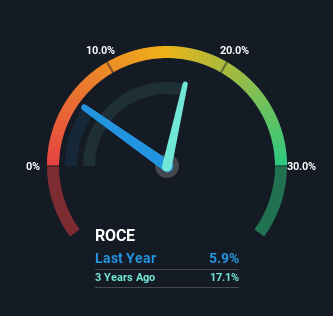- India
- /
- Hospitality
- /
- NSEI:APOLSINHOT
Capital Allocation Trends At Apollo Sindoori Hotels (NSE:APOLSINHOT) Aren't Ideal
Finding a business that has the potential to grow substantially is not easy, but it is possible if we look at a few key financial metrics. One common approach is to try and find a company with returns on capital employed (ROCE) that are increasing, in conjunction with a growing amount of capital employed. Basically this means that a company has profitable initiatives that it can continue to reinvest in, which is a trait of a compounding machine. However, after investigating Apollo Sindoori Hotels (NSE:APOLSINHOT), we don't think it's current trends fit the mold of a multi-bagger.
What is Return On Capital Employed (ROCE)?
For those who don't know, ROCE is a measure of a company's yearly pre-tax profit (its return), relative to the capital employed in the business. To calculate this metric for Apollo Sindoori Hotels, this is the formula:
Return on Capital Employed = Earnings Before Interest and Tax (EBIT) ÷ (Total Assets - Current Liabilities)
0.059 = ₹71m ÷ (₹1.6b - ₹440m) (Based on the trailing twelve months to December 2021).
So, Apollo Sindoori Hotels has an ROCE of 5.9%. In absolute terms, that's a low return and it also under-performs the Commercial Services industry average of 8.8%.
Check out our latest analysis for Apollo Sindoori Hotels

While the past is not representative of the future, it can be helpful to know how a company has performed historically, which is why we have this chart above. If you want to delve into the historical earnings, revenue and cash flow of Apollo Sindoori Hotels, check out these free graphs here.
What Can We Tell From Apollo Sindoori Hotels' ROCE Trend?
In terms of Apollo Sindoori Hotels' historical ROCE movements, the trend isn't fantastic. Over the last five years, returns on capital have decreased to 5.9% from 28% five years ago. Although, given both revenue and the amount of assets employed in the business have increased, it could suggest the company is investing in growth, and the extra capital has led to a short-term reduction in ROCE. If these investments prove successful, this can bode very well for long term stock performance.
On a related note, Apollo Sindoori Hotels has decreased its current liabilities to 27% of total assets. That could partly explain why the ROCE has dropped. Effectively this means their suppliers or short-term creditors are funding less of the business, which reduces some elements of risk. Since the business is basically funding more of its operations with it's own money, you could argue this has made the business less efficient at generating ROCE.
The Bottom Line On Apollo Sindoori Hotels' ROCE
Even though returns on capital have fallen in the short term, we find it promising that revenue and capital employed have both increased for Apollo Sindoori Hotels. Furthermore the stock has climbed 73% over the last five years, it would appear that investors are upbeat about the future. So while the underlying trends could already be accounted for by investors, we still think this stock is worth looking into further.
One final note, you should learn about the 3 warning signs we've spotted with Apollo Sindoori Hotels (including 1 which is a bit unpleasant) .
While Apollo Sindoori Hotels may not currently earn the highest returns, we've compiled a list of companies that currently earn more than 25% return on equity. Check out this free list here.
New: Manage All Your Stock Portfolios in One Place
We've created the ultimate portfolio companion for stock investors, and it's free.
• Connect an unlimited number of Portfolios and see your total in one currency
• Be alerted to new Warning Signs or Risks via email or mobile
• Track the Fair Value of your stocks
Have feedback on this article? Concerned about the content? Get in touch with us directly. Alternatively, email editorial-team (at) simplywallst.com.
This article by Simply Wall St is general in nature. We provide commentary based on historical data and analyst forecasts only using an unbiased methodology and our articles are not intended to be financial advice. It does not constitute a recommendation to buy or sell any stock, and does not take account of your objectives, or your financial situation. We aim to bring you long-term focused analysis driven by fundamental data. Note that our analysis may not factor in the latest price-sensitive company announcements or qualitative material. Simply Wall St has no position in any stocks mentioned.
About NSEI:APOLSINHOT
Apollo Sindoori Hotels
Operates as a hospitality service management and support services company in India.
Excellent balance sheet with proven track record.
Market Insights
Community Narratives


Recently Updated Narratives

Astor Enerji will surge with a fair value of $140.43 in the next 3 years

Proximus: The State-Backed Backup Plan with 7% Gross Yield and 15% Currency Upside.


A case for for IMPACT Silver Corp (TSXV:IPT) to reach USD $4.52 (CAD $6.16) in 2026 (23 bagger in 1 year) and USD $5.76 (CAD $7.89) by 2030
Popular Narratives


MicroVision will explode future revenue by 380.37% with a vision towards success


The company that turned a verb into a global necessity and basically runs the modern internet, digital ads, smartphones, maps, and AI.



